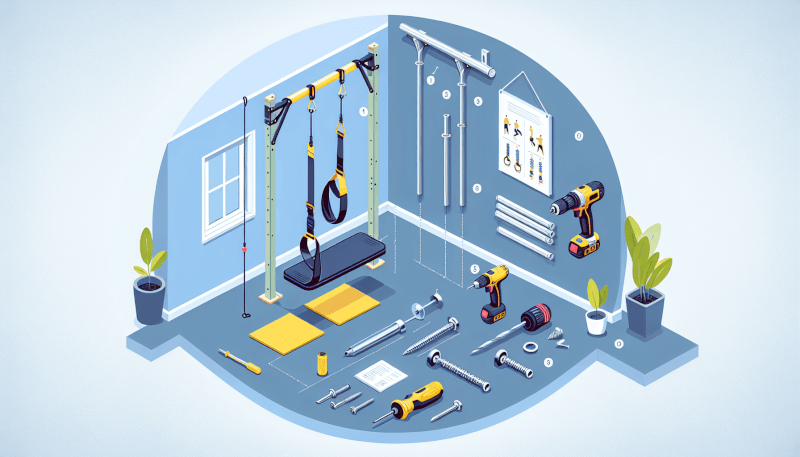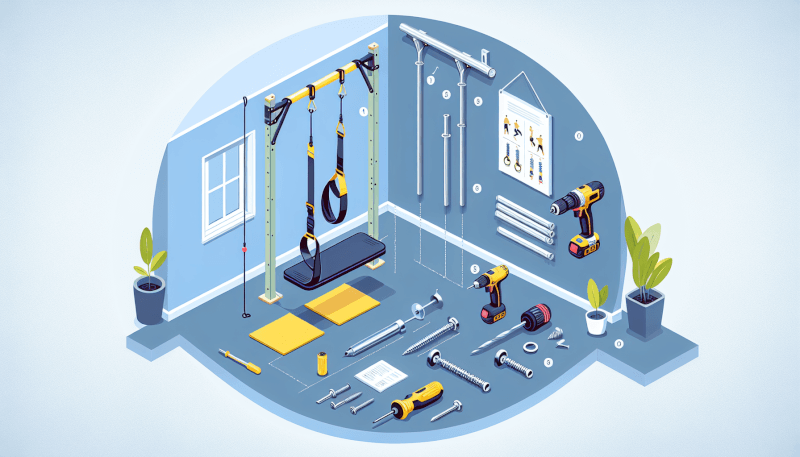If you’re looking to create your own home gym and want to incorporate a suspension trainer, you’ve come to the right place. In this article, we’ll provide you with some helpful tips for installing a DIY home gym suspension trainer mount. Whether you’re a seasoned fitness enthusiast or just starting out, these tips will ensure that your installation process is smooth and successful. So grab your tools and let’s get started on transforming your home into the ultimate workout space!

Choosing the Right Location
When it comes to installing a home gym suspension trainer mount, one of the first things you need to consider is selecting the right location. The chosen location should provide enough space and structural support for the suspension trainer to be safely mounted. Here are a few factors to keep in mind when choosing the ideal spot for your suspension trainer.
Assessing the Space
Start by evaluating the available space in your home or outdoor area. Ensure that the location you choose has enough space for you to perform exercises without restrictions. Make sure there are no obstacles or furniture that could interfere with your movements while using the suspension trainer. Additionally, consider whether you want to have the suspension trainer mounted indoors or outdoors based on your personal preferences and the available space.
Considering Structural Support
The next consideration is the structural support of the chosen location. The suspension trainer must be mounted on a sturdy and secure surface to ensure your safety during workouts. If you plan to install the suspension trainer indoors, look for beams or studs in the ceiling or walls that can support the weight and force applied during exercises. For outdoor installations, make sure the tree or branch you plan to use is robust enough to handle the load.
Determining Ceiling Height
Ceiling height is another crucial factor to consider when determining the location for your suspension trainer. The ideal ceiling height should allow you to perform exercises comfortably while having enough clearance from the ground or any other obstacles. Make sure to measure the ceiling height in the selected area to ensure it meets your needs before proceeding with the installation.
Clearing the Area
Before installing your suspension trainer, clear the area of any objects or furniture that may hinder your movements. Remove any items that are within the exercise range of the suspension trainer to prevent accidents or damage. Having a clean and open space will not only enhance your workout experience but also ensure your safety while using the suspension trainer.
Mounting Options
When it comes to installing a home gym suspension trainer mount, there are several mounting options to choose from. The right mounting option for you depends on the available space, structural support, and personal preference. Here are some common mounting options you can consider:
Ceiling Mount
A ceiling mount is an excellent choice if you have a sturdy ceiling or overhead beams that can support the suspension trainer’s weight. With a ceiling mount, you can enjoy full 360-degree range of motion during your exercises. It provides a stable and secure setup for your suspension trainer, allowing you to perform various workouts with confidence.
Wall Mount
If you prefer to have your suspension trainer mounted on a wall, a wall mount is the way to go. Look for wall studs that can provide the necessary support for the suspension trainer. Wall mounts are a space-saving option, especially for those with limited ceiling height or clearance. They provide a stable anchor point for your suspension trainer while allowing you to perform a wide range of exercises.
Door Mount
For those who want a portable option or don’t have a suitable ceiling or wall to mount the suspension trainer, a door mount is an excellent solution. Door mounts typically consist of an anchor that goes over the top of the door and a strap that loops around it. This type of mount allows you to use your suspension trainer in different locations around the house or take it with you on-the-go.
Tree/Branch Mount
If you prefer to take your workouts outdoors or don’t have suitable indoor mounting options, consider a tree or branch mount. Before using a tree or branch as your anchor point, ensure that it is sturdy and strong enough to support your weight. Use a tree protector to avoid damaging the bark and wrap the suspension trainer securely around the tree or branch to create a safe and stable setup.
Beam Mount
Beam mounts are specifically designed for suspending equipment from exposed ceiling beams. If you have exposed beams in your home or garage, a beam mount can be a perfect choice. Identify the load-bearing beams in your ceiling, measure the mounting points, and secure the mounting plate to create a sturdy and reliable anchor point for your suspension trainer.

Required Tools and Materials
Before starting the installation of your home gym suspension trainer mount, make sure you have all the necessary tools and materials. Here’s a list of what you’ll need:
Stud Finder
A stud finder is essential for locating the beams or studs in your ceiling or walls. It helps you identify the secure anchor points for your suspension trainer mount.
Measuring Tape
A measuring tape will come in handy to ensure accurate placement and measurements during installation.
Drill
A drill is necessary to create pilot holes and secure the mounting brackets or plates to the desired location.
Screws or Bolts
Choose the appropriate screws or bolts based on the mounting surface and the weight capacity of your suspension trainer. Make sure they are long and sturdy enough to provide a secure attachment.
Level
Use a level to ensure that your suspension trainer mount is properly aligned and straight.
Pencil or Marker
A pencil or marker is useful for marking the mounting points on the ceiling or walls before drilling.
Wrench or Socket Set
A wrench or socket set will be required to tighten and secure the screws or bolts during the installation process.
Anchors (if needed)
If your chosen mounting surface doesn’t have suitable studs or beams, you may need to use anchors to provide additional support and stability.
Swivel Hook or Carabiner
A swivel hook or carabiner is used to attach the suspension trainer to the mount, allowing for smooth movement and rotation during exercises.
Suspension Trainer
Of course, you’ll need a suspension trainer to complete your home gym setup. Make sure you have the necessary trainer and straps before proceeding with the installation.
Pre-Installation Preparation
Before diving into the installation process, it’s crucial to adequately prepare to ensure a smooth and successful installation. Here are a few pre-installation steps to follow:
Read Product Instructions
It’s essential to read and understand the product instructions provided with your suspension trainer mount. Familiarize yourself with the installation process, any specific requirements or precautions, and the weight capacity of the mount.
Gather All Tools and Materials
Make sure you have all the necessary tools and materials listed above before you begin the installation. Having everything ready beforehand will save you time and prevent interruptions during the process.
Clear the Area
Clear the area where you plan to install the suspension trainer mount. Remove any furniture, decorations, or other items that might obstruct your installation process. Having a clear workspace will make it easier for you to work efficiently and ensure a safe installation.
Ensure Safety Measures
Before starting any installation, ensure that you have taken appropriate safety measures. This includes wearing safety glasses to protect your eyes from debris, having a stable ladder or stool to reach high mounting points, and having a first aid kit on hand in case of any accidents.

Ceiling Mount Installation
If you have chosen a ceiling mount for your suspension trainer, here are the steps to follow for a successful installation:
Locate Studs or Beams
Use a stud finder to locate the beams or studs in your ceiling. These will provide the necessary structural support for your suspension trainer mount. Mark the locations for your mounting points using a pencil or marker.
Mark Mounting Points
Using a level, mark the precise points where you will be drilling to attach the mounting brackets or plates. Ensure that the marks align with the studs or beams you located previously.
Drill Pilot Holes
Using a drill with an appropriate bit size, carefully drill pilot holes into the marked mounting points. Take care not to drill too deep or damage any structural elements in your ceiling.
Attach Mounting Bracket
Place the mounting brackets or plates over the pilot holes and align them with the marked mounting points. Screw or bolt them into place, ensuring a secure and tight fit. Use a wrench or socket set to tighten the screws or bolts.
Secure Suspension Trainer
Attach the suspension trainer to the mounting brackets or plates using a swivel hook or carabiner. Ensure that the trainer is properly secured and can support your weight. Give it a gentle tug to ensure it doesn’t give way before starting your workout.
Wall Mount Installation
If you have opted for a wall mount for your suspension trainer, follow these steps for a successful installation:
Find Wall Studs
Using a stud finder, locate the wall studs where you will be mounting the suspension trainer. Mark the locations with a pencil or marker to indicate the precise mounting points.
Mark Mounting Points
Using a level, mark the precise points where you will be drilling for the mounting brackets or plates. The marks should align with the wall studs you located earlier.
Drill Pilot Holes
Carefully drill pilot holes into the marked mounting points, ensuring that the holes are the appropriate size for the screws or bolts you will be using.
Attach Mounting Bracket
Place the mounting brackets or plates over the pilot holes, aligning them with the marked mounting points. Secure them in place by screwing or bolting them tightly. Use a wrench or socket set to ensure a secure fit.
Secure Suspension Trainer
Attach the suspension trainer to the mounting brackets or plates using a swivel hook or carabiner. Ensure that the suspension trainer is properly secured and can support your weight. Give it a gentle tug to confirm its stability before starting your workout.

Door Mount Installation
If you have chosen a door mount for your suspension trainer, follow these steps for a successful installation:
Choose Suitable Door
Select a sturdy door that can support your weight and the force applied during exercises. Avoid using doors with glass panels or doors with weak frames, as they may not be able to withstand the stress of the suspension trainer.
Check Door Stability
Before attaching the door anchor, check the stability of the door by giving it a firm push or pull. If the door feels loose or unstable, it may not be suitable for a suspension trainer mount. In such cases, consider choosing another mounting option or reinforcing the door before proceeding.
Install Door Anchor
Place the door anchor over the top edge of the door, ensuring that it securely fits. Close the door and gently pull on the anchor to confirm its stability. If the anchor feels loose or unstable, readjust the placement or choose an alternative door.
Attach Suspension Trainer
Attach the suspension trainer to the door anchor using the provided attachment point. Make sure the suspension trainer is properly secured and can support your weight. Give it a gentle tug to ensure its stability before starting your workout.
Tree/Branch Mount Installation
If you prefer an outdoor workout setting or lack suitable indoor mounting options, follow these steps for a tree or branch mount installation:
Evaluate Tree/Branch Strength
Before using a tree or branch as your anchor point, make sure it is strong and sturdy enough to support your weight. Avoid trees or branches that appear weak, damaged, or diseased. Choose a healthy, robust tree or branch that can provide the necessary support and stability.
Use Tree Protector
To prevent damage to the tree or branch, use a tree protector. This can be a thick piece of fabric or a specialized tree strap that wraps around the tree or branch at the attachment point of the suspension trainer.
Wrap Suspension Trainer Around
Wrap the suspension trainer securely around the tree or branch, ensuring that it is snug and won’t slip or slide during your workouts. Double-check the attachment point to guarantee its stability.
Test for Stability
Give the suspension trainer a gentle tug to test its stability. If it feels secure and does not give way, it is ready for use. If it feels unstable or loose, readjust the wrapping or choose another tree or branch with better stability.

Beam Mount Installation
For those with exposed ceiling beams, a beam mount installation is a suitable option. Follow these steps for a successful beam mount installation:
Identify Load-Bearing Beam
Identify the load-bearing beams in your ceiling that are capable of supporting the weight and force applied during your workouts. Consult a professional or refer to your home’s blueprints if necessary. Knowing the load-bearing beams will ensure a safe and secure installation.
Measure Mounting Points
Using a measuring tape, measure and mark the appropriate mounting points on the load-bearing beams. Ensure that the marks are evenly spaced and aligned.
Drill Pilot Holes
Carefully drill pilot holes into the marked mounting points on the load-bearing beams. Take care not to drill too deep or damage the beams in the process.
Secure Mounting Plate
Attach the mounting plate to the load-bearing beams using screws or bolts, depending on the provided instructions. Ensure that the mounting plate is tightly secured and will not give way during use.
Attach Suspension Trainer
Attach the suspension trainer to the mounting plate using a swivel hook or carabiner. Check the stability and security of the suspension trainer by giving it a gentle tug. If it feels secure, it’s ready for use.
Post-Installation Safety Checks
After successfully installing your home gym suspension trainer mount, it’s important to conduct regular safety checks to ensure its continued reliability and your safety. Here are a few essential post-installation safety checks:
Weight Capacity
Regularly check the weight capacity of your suspension trainer mount to ensure that it can still support your weight and the additional force applied during exercises. Follow the manufacturer’s guidelines regarding weight limits and make any adjustments or upgrades if necessary.
Suspension System Integrity
Inspect the suspension trainer, mounting brackets or plates, and any other components of the suspension system for signs of wear, damage, or weakening. Look for frayed straps, loose bolts, or any other issues that could compromise the integrity of the system. Address any problems immediately to avoid accidents or injuries.
Regular Inspections
Perform routine inspections of your suspension trainer mount to check for any signs of damage or loosening. This includes checking the mounting points, screws or bolts, and the overall stability of the installation. Make any necessary repairs or adjustments to ensure continued safety and functionality.
Proper Maintenance
Take the time to clean and maintain your suspension trainer mount regularly. Check for any buildup of dirt, dust, or debris that could affect the system’s performance. Lubricate any moving parts as recommended by the manufacturer. Proper maintenance will prolong the lifespan of your suspension trainer mount and keep it in optimal condition.
Usage Guidelines
Always follow the manufacturer’s usage guidelines when using your suspension trainer mount. This includes adhering to the recommended exercises, weight limits, and safety precautions. Using the suspension trainer mount correctly and responsibly will minimize the risk of accidents or injuries.
By following these installation tips and safety guidelines, you can enjoy a safe and efficient home gym suspension trainer mount. Remember to choose the right location, use the appropriate mounting option, gather all the necessary tools and materials, and conduct regular safety checks to ensure a successful and enjoyable workout experience. Happy training!


